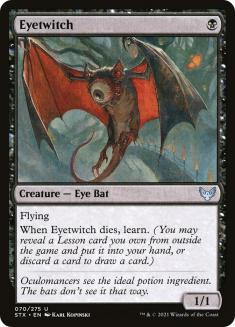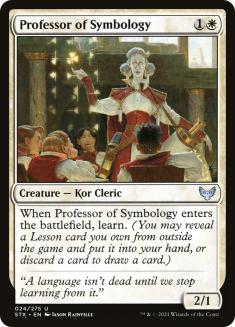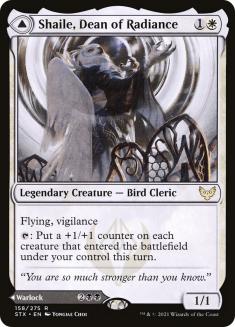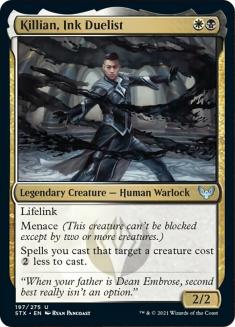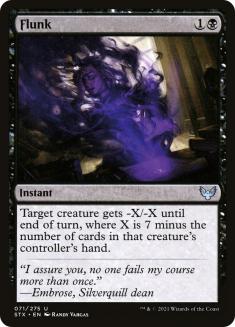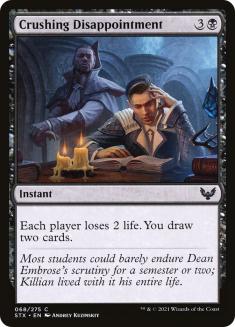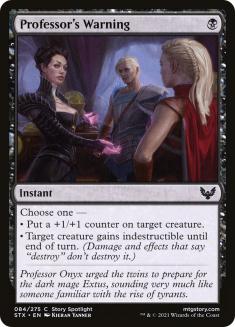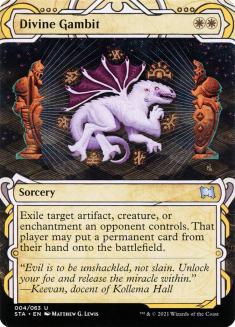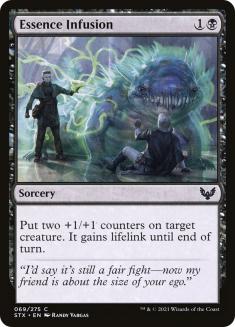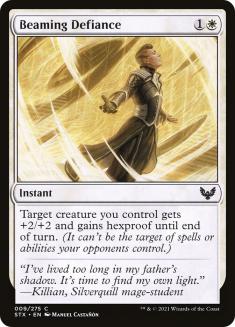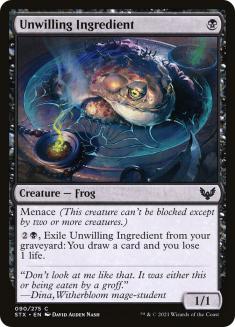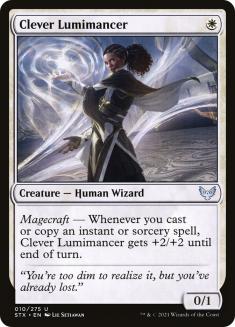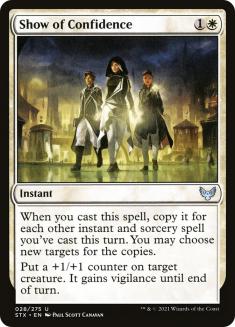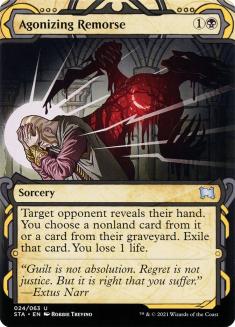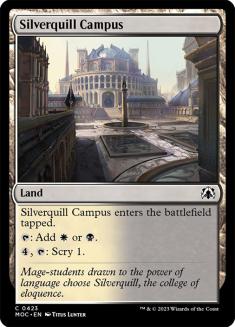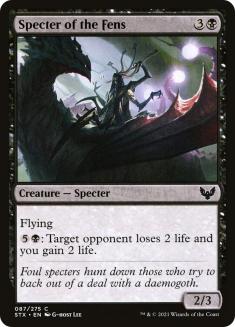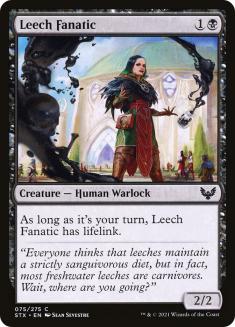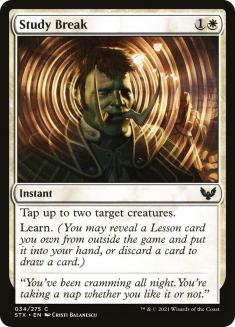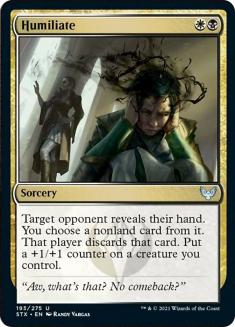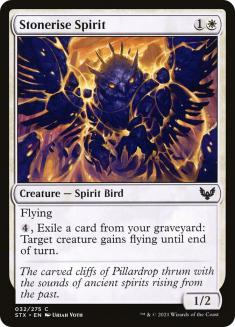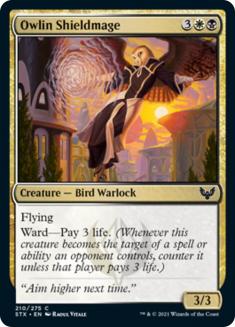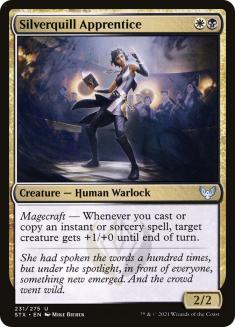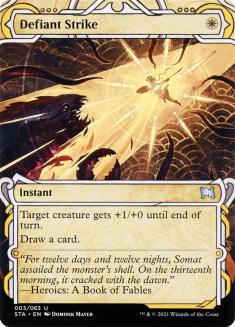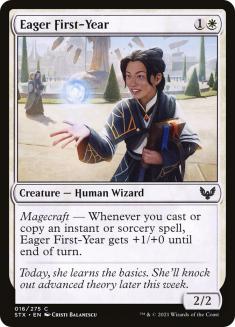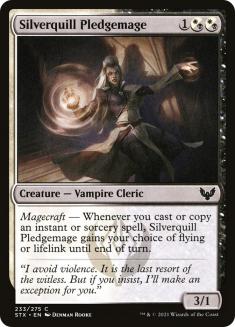It started with a ridiculous self-assigned stipulation.
I must make Top 1200 Mythic on Magic Arena by forcing Silverquill every draft.
The college had been so criminally underrated by the bots for the first two weeks of Strixhaven Quick Draft that it was drafted twice as many times as the next highest color pairing (6,957 versus 3,630 for Witherbloom). We’re talking early days of Dimir in Guilds of Ravnica-level drafting by the bots, showing Iron Giant levels of kindness to humans. Plus, I love a futile mission.
So I started an account, threw a fiver at it, and eighteen drafts later, I was sitting at #214 with ten trophies under my belt.
My goal in this column is to show you ways to exploit the Quick Draft format for your monetary gain and ladder ranking. Sure, I’ve made the percentages in Constructed a few of times, but as a fairly average player, I’ve made thirteen Mythic Qualifier Day 1s off my Limited ranking. If you’re sick of cashing in wild cards to chase the daily metagame like I was, this is your path.
One big disclaimer: occasionally, these bots are updated and my advice will be nerfed. The data I reference from 17Lands.com is as of this article being published, so please don’t @ me on Twitter with screenshots claiming I’m an idiot. I’m an idiot for myriad other reasons.
Archetype Breakdown
At first glance, Silverquill wants you to think that +1/+1 counter synergies are like Weekend Update to Saturday Night Live: not worth playing without them. In reality, they play out more like a Digital Short, where it’s nice but not required. Instead, you’ll be going under durdling Prismari/Quandrix (which I’ll refer to as Prisdrix from here on out) decks with an aggressive early-game, and then using either flyers or tricks to close them out.
Living Your Best Lessonboard
This format is defined by having access to the best Lessons. Do this and you’ll flat-out win more. Fortunately, Silverquill gives you early access to your Lessonboard with all-stars like Guiding Voice, Study Break, Hunt for Specimens, Eyetwitch, and mythic uncommon Professor of Symbology. Sure, other colors have early learning options, but none of them consistently affect the battlefield as we do. We’re at Montessori school; they’re a toddler with an iPad on 12% battery.
When you fetch early and often, you’re able to dictate your opponents’ plays in ways that benefit you. Grabbing an Expanded Anatomy when secretly holding a Professor’s Warning or Beaming Defiance flips an information disadvantage in your favor. We’re also positioned well to take advantage of Inkling, Spirit, and Pest Summoning (ranked in order) to force aggressive starts. The bots think we’re obsessed with Environmental Sciences while we casually litter all over our opponents who cast them.
Two-Drop It Like It’s Hot
Of the top three best cards to have in your opening hand, two are Silverquill: Shaile, Dean of Radiance and Killian, Ink Duelist. You read that right. A Killian in your starting seven gives you a 69.6% (nice) win rate. The Top 15 also includes the aforementioned Professor of Symbology, Thunderous Orator, and Leonin Lightscribe. Building out your battlefield while your Quandrix opponents waste mana ramping begins with your two-mana value slot, of which Sam Black has extolled the virtues.
Here, we have an embarrassment of riches. Our magecraft package boasts Eager First-Year and Silverquill Apprentice to take advantage of our tricks and Lessons. Evasion? Arrogant Poet and Stonerise Spirit get in early and often. Leech Fanatic helps us win races. Almost all of them scale with the game, a treat for aggro instead of watching your army get brick-walled by a vanilla 2/4.
I Just Want to Fly
Thanks to a few hybrid mana, just like a Prius, we never run out of gas. (Okay, I’m not exactly sure how cars work.)
Silverquill Pledgemage and Shadewing Laureate both give you the reach you need to finish off opponents for the low, low cost of three mana. The former never lacks for magecraft triggers, while the latter hasn’t impressed me much but occasionally generates some value in the form of those counters we don’t care about. Be prepared to trade with a Scuirrid Colony and feel underwhelmed one game, then a Waterfall Aerialist and feel thoroughly whelmed the next.
Rounding out our top-end is Combat Professor and Specter of the Fens at mana value four, with Owlin Shieldmage at the five-mana slot. More on them in a bit.
One Hand in Their Pocket
So much emphasis on learn/Lesson leaves hand disruption particularly well-positioned without the feels bad of drawing into a spell while your opponent is cardless and digitally smirking. Counting the Mystical Archive, we have access to Humiliate, Agonizing Remorse, Inquisition of Kozilek, and Duress (ranked in order of best to worst) with Go Blank as a best-of-one stay away. A typical play pattern will look something like a Turn 3 Humiliate, stealing their best stabilizer while turning your magecraft-enabled two-drop into a 4/3 that’s ready for blood.
Like seeing someone on TikTok climbing a ladder, it’s often backbreaking.
Uptown Flunk
The amount of removal you have early access to in black alone makes this deck feel filthier than Rick James’s couch. Lash of Malice, Doom Blade, Eliminate, Flunk, Despark, Vanishing Verse, and even the occasional Baleful Mastery at two mana or less? I get it: there’s a fair share of rares and Mystical Archive cards in there, but you’re often looking at a package with some combination of these plus a Closing Statement or Mage Hunters’ Onslaught to boot. The best part? You’ll often be able to hold your unconditional removal for targets later in the game, as your early combat tricks will clear the way early on.
It’s Not Tricky
Speaking of, this deck thrives on sorcery-speed buffs for your creatures, which sounds like the fastest path to an 0-3 outside of playing whatever these bots are actually drafting. According to 17Lands, the single best white common you can start the game with is Guiding Voice, and this bears out in my testing. It’s incredibly rare for your opponent to disrupt it, you get access to the Lesson you need next, and it usually means getting through for damage instead of trading. An honorable mention to the number of times an Essence Infusion plus Unwilling Ingredient/Eyetwitch got in for nine of the silliest damage you ever did see.
Oops… I Won It Again
Confession: I love conceding. With limited hours in the day to draft, I need to maximize my matches and sometimes that means scooping when I feel my opponent has inevitability.
With Silverquill Aggro, I’m drawing every last card. I’m not even mad. It’s amazing.
Study Break creates broken turns where you get to tap your opponents’ two best creatures, Expanded Anatomy your weakest, and steal games from out of nowhere. Other times, you’ll have a Silverquill Pledgemage that becomes a Craw Wurm out of nowhere (Guiding Voice + Anatomy) and gains you six life. A Mage Hunters’ Onslaught turns profitable blocks for your opponents into lethal damage. You very rarely feel like a game is out of reach.
How to Draft the Deck
First, forcing this every time is not a strong strategy and I will not be responsible for draft logs where you pass a Prismari Command to take an Environmental Sciences. While the number of Pack 1, Pick 1s that will pull me into Prisdrix are getting smaller every day, this is not the only deck on Arena. It’s just the best one.
Second, do not start a draft before finishing this article. While it’s one thing to know what to take, the most important knowledge to have when drafting against bots is to know when to take it. We play our first game against the AI, then our opponents. As such, I’m going to focus on what you can get wheeled first.
Playables That Will Wheel in Order of How Likely They Are to Wheel
Crushing Disappointment (Average Taken At: 12.07)
Yes, you will kill an opponent with the two damage, but more importantly, the incidental lifegain the deck generates makes the damage irrelevant to you. You never want more than one but can help you re-up while triggering magecraft.
Professor’s Warning (ATA: 11.67)
The more magecraft I have, the better I feel about Professor’s Warning, as it’s a serviceable combat trick that fails its mission against Bury in Books, Divide by Zero, and Aether Helix.
Divine Gambit (ATA: 11.05)
A solid overperformer in the mirror and often a great hit against Prisdrix decks that fill the top of their curve with Leyline Invocation, Elemental Masterpiece, etc. Often, a discard effect will help you know you’re in the clear from a Bookwurm ruining your day.
Essence Infusion (ATA: 10.80)
I know. It seems so bad. I didn’t believe it either. Sometimes, you need to bait your opponent into killing your Eyetwitch while getting meaningful damage in.
Beaming Defiance (ATA: 10.79)
A linchpin that helps you win combat, prevents buffed brawlers from getting bounced, and keeps your spell count high for magecraft.
Unwilling Ingredient (ATA: 10.26)
Even the most ardent lover of frog’s legs would say this is too high to take this little bugger. You’re only including it in the most aggressive, counter-based shells.
Clever Lumimancer/Show of Confidence (ATA: 9.78, 9.86)
Packaging these as you’ll only want to run them in your most aggressive of magecraft decks but are the exact kind of speculative picks you want to be making, as you never find yourself short on playables.
Agonizing Remorse (ATA: 9.79)
With Humiliate taken at 8.83 on average, I’m not too stressed if I need to take a two-drop or area of need over this, but keep in mind that just because it’s from the Mystical Archive doesn’t mean the bots are jumping on it.
Silverquill Campus (ATA: 9.67)
I’ll caution that this is still an aggro deck and too many lands that enter the battlefield tapped can ruin your momentum, so I tend to stop at one Campus.
Specter of the Fens (ATA: 9.54)
This number seems high to me, even if its activated ability is a solid way to finish out a game. I regularly see Specters available Pick 12 and later, making it a true steal that you don’t even have to think about.
Leech Fanatic (ATA: 9.45)
Picking up a couple of Leech Fanatics along the way allows you to cheat on your two-drops if your pod is light on them or you’re forced to take better cards elsewhere in the draft. They’re not much, but they do honest work, especially when you slap some overalls on them.
Study Break (ATA: 9.23)
In a weak pack, I’m not taking the gamble of this coming back around, as it’s so critical to have at least one in any deck, as you need access to your Lessons. It’s like trying to make pancakes, getting everything ready, and then realizing you don’t have any eggs. No one wants to eat your bad pancakes or play this deck without a Study Break. Take stock of what the bots will pick over it before passing.
Mid-Round Value
Knowing that you have roughly half of your draft deck available for peanuts is part of what makes this strategy so forceable, so now let’s cover what you’ll be able to get at the end of packs:
Humiliate (ATA: 8.90)
I’ve extolled its virtues elsewhere as the top discard spell for the deck, but I’ll note that it gets worse in multiples.
Stonerise Spirit (ATA: 8.63)
I treat these as filler, as a number of your creatures should be decently evasive on their own, making it a highly situational inclusion.
Owlin Shieldmage (ATA: 8.11)
Having ward of three life is incredibly relevant text, as your opponent will often be forced to treat this as hexproof after an aggressive start. The only downside is costing five mana, as I’d much rather run sixteen lands with the Best-of-One hand smoother than have three Owlins howlin’.
Silverquill Apprentice (ATA: 7.76)
Nothing you love more than an on-college two-drop with magecraft going this late (and later) to help fill out your curve. It’s tempting to take these earlier than necessary, but hold out for as long as you can (Pick 10 isn’t unheard-of).
Defiant Strike (ATA: 7.50)
The more magecraft you have, the better this obviously becomes, being one of the stronger ways to trigger multiple times in a turn while doing a decent Guiding Voice impression.
Eager First-Year (ATA: 7.17)
Yet another bread-and-butter two-drop you will be kicking yourself for not drafting more of when you’re getting too cute. I’m constantly impressed with how often you trade up with almost no work.
Silverquill Pledgemage (ATA: 6.12)
Truly an all-star of the deck due to the versatility of situational lifelink when racing or flying when you need to get after your opponent’s face. The times when you get both are just a chef’s kiss.
The Early Picks
At this point in the format, I feel like pick orders are well-established and based on personal preferences, like your taste in fancy cheese. Broadly, I’m taking bombs first, then removal and Lessons (certainly no reinvention of the wheel), but keep an eye out for Dramatic Finale and Poet’s Quill, two rares you’ll be confused seeing Picks 4-6.
Augusta, Dean of Order is easy to miss when you have your blinders on and only see Plargg, Dean of Chaos, but then again, you won’t be drafting with this bonkers stipulation. I currently have the common Lessons ranked for this deck as Inkling Summoning, Expanded Anatomy, Spirit Summoning, Introduction to Annihilation, Introduction to Prophecy, Environmental Sciences, and Pest Summoning as dead last.
It’s hard to go off the rails early, though, so don’t overthink it.
Traps to Avoid
- Going wide. There’s a temptation to look at all of these cheap creatures and think that Defend the Campus or Exhilarating Elocution represents a path to victory, but this fails as so many resources are devoted to buffing and protecting our squad. Defend the Campus should only be used for destruction and, even then, only if we’re desperately short on interaction. When in doubt, remember that “Defend” isn’t high on your list of priorities.
- Counters. Dueling Coach, Tenured Inkcaster, and Spiteful Squad don’t have the bodies you need for this mission. Of the three, I’m most likely to play Inkcaster as its passive can end games on the spot, but it’s very situational compared to Owlin, a body I’m always happy to have. Turns 4 and later are focused on ways you can end the game, not survive longer.
- Most One-Drops. Repeat after me: “I promise not to cast Star Pupil.” The data absolutely murders this card, where drawing it makes you 6.5% less likely to win, slightly edging out one-mana value dud Stonebinder’s Familiar (6.2%). “Sure, Jake, but having it in your opening hand must make it better.” You’re right! It’s only the fourth-worst white card to have to start. It doesn’t even make Par Pupil. The most aggressive versions will be content to cast Eager Lumimancer, Eyetwitch, and the occasional Unwilling Ingredient.
- Rise of Extus. Scorching hot take alert! I don’t care for Rise of Extus and feel like I’m begrudgingly playing one every time it makes my 40. There’s plenty of removal and learn running around, so why am I going out of my way to play something this expensive at the top of my curve? Especially when I have to make concessions like playing….
- Pilgrim of the Ages. This feels like the wrong format for the Pilgrim, with Lorehold Control failing to become viable and Silverquill Aggro not particularly concerned about finding a Plains with such a weak body left behind. If I’m stuck with a Rise of Extus or two, sure, he’ll also make the deck, but I’m not amused. Much like the actual Pilgrims, it’ll take the rewriting of history to make him seem palatable by the end of the format. (Leave it to the design team at WotC to give us a white Pilgrim that grabs a land.)
- Splashing. I am guilty of taking allied Campuses at the end of packs on the off-chance that I’ll snag a bomb in Lorehold or Witherbloom and deliver on them, but it’s truly not needed and will often disrupt your fast starts or leave you with an uncastable mythic you rummage away with learn. Even relatively easy splashes like Beledros Witherbloom come at the cost of raising your curve dramatically and possibly wasting an early pick on Environmental Sciences, so stay disciplined, my friend.
From My Not-So-Mystical Archives
Here are a few sample trophies to illustrate the different ways you can build rather than treating it like a modular home in the suburbs.
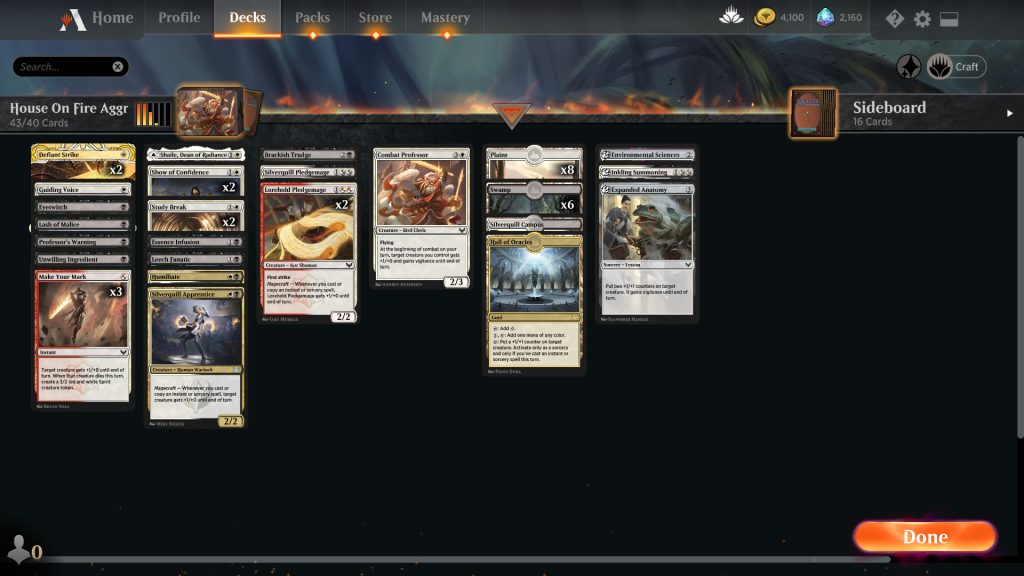
I call this “House on Fire Aggro” because you’re piling all of your threats into a box and hoping to get out alive. In extremely spell-heavy decks like this, I love Lorehold Pledgemage and Show of Confidence as ways to turn an unblocked two damage into twelve.
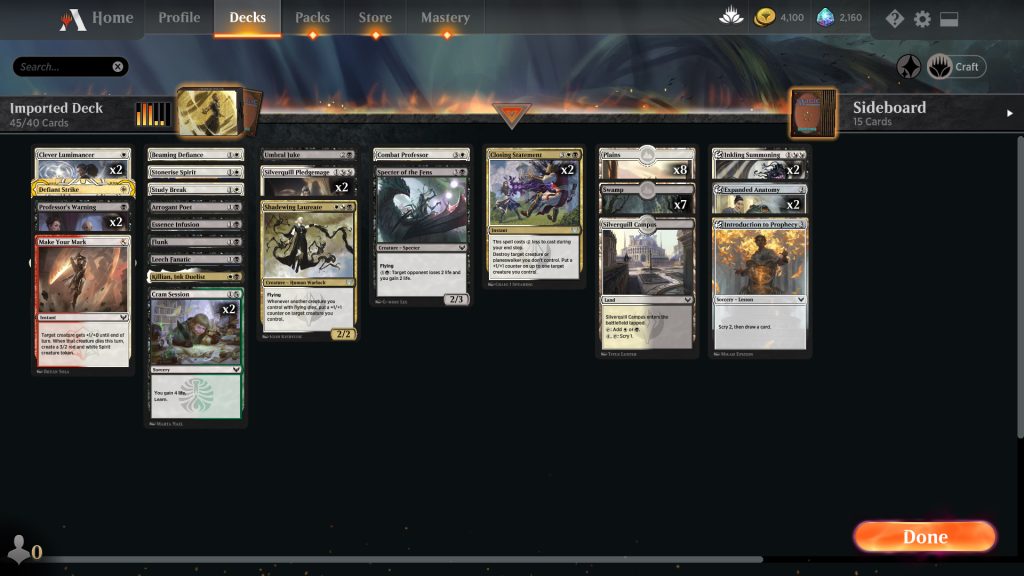
With two Lumimancers, you’re usually banking on cheap spells to push them to their limits, but Killian’s passive ability means that I’m often triple-spelling with better-quality cards starting on Turn 3. Note that this build has not one but two Cram Sessions to get access to the ridiculous Lessonboard.

Don’t forget to account for your Lessons when calculating your curve. This deck would have benefited from a Professor or Guiding Voice to have more consistent plays on Turn 3, but still got there.
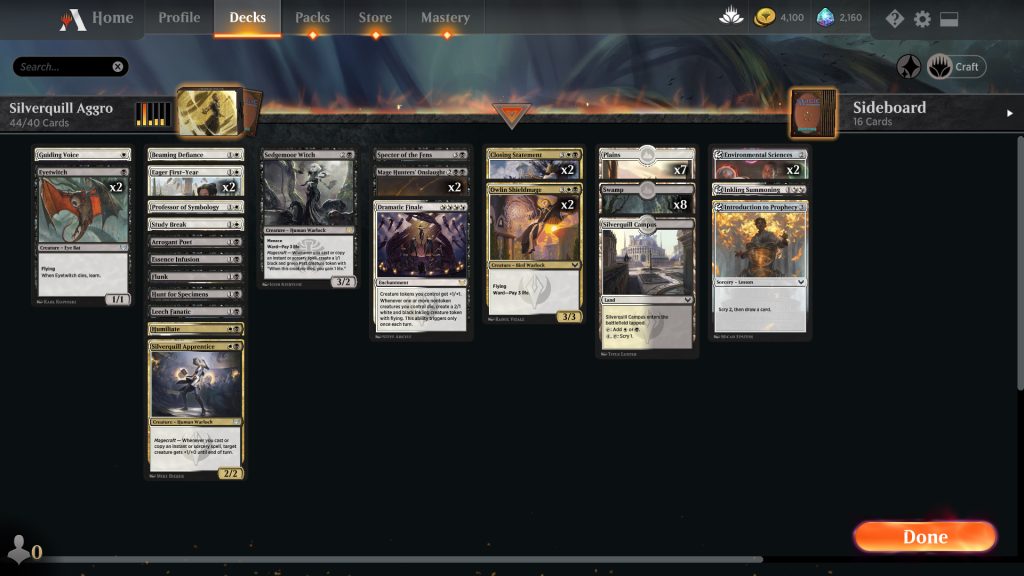
This is what I would consider your base Silverquill Aggro deck: not balls-to-the-wall aggressive, but not midrange, either.
Closing Time
Silverquill Aggro finally broke me from the Temur piles I loved early in Strixhaven Draft and I hope it does for you, too. While I’d rather be drawing a ton of cards and casting giant Fractals, this is what the bots are giving us, so we must take from our robot overlords. Between some of the best removal packages, clever interactions, and devastating turns that appear out of nowhere, it’s an incredibly versatile deck that I’ll miss dearly after the next update.
Until then, I’ll see you in The Matrix.


